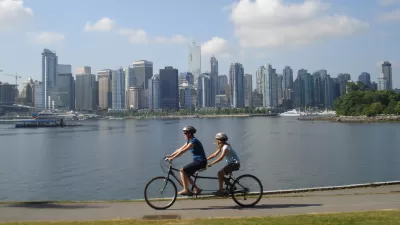Bob Ransford argues that the policies that have shaped Vancouver's streets and skyline over the last decades into a global icon of planning and design are an accomplishment of style over substance that fail to look at how people inhabit buildings.
Ransford defines "Vancouverism" as "a
design trend that has among its key principles residential buildings
that are in the form of thin point towers with a podium at street level
wrapped with townhouses providing 'eyes on the street.'" And while these principles, along with a focus on glass-glad buildings, make for pretty architecture, Ransford and architect Gair Williamson surmise that they fail to acknowledge the changing needs of users.
"These are conservative times, but technological
changes are changing values and shaping different ways people want to
live and work. Meanwhile, architects are reverting to classic solutions -
classic meaning something that is timeless and not adaptable," says Williamson.
While Ransford attempts to assign responsibility for the failure to re-imagine "the substance" inside the city's stylish new buildings to those who've established the framework for how the city has evolved, Williamson puts the blame squarely on architects.
"‘You can blame city hall, the client, the public consultation process or
the project budget, but in fact it is the disinterest of those involved
in the design process who, with a few exceptions, fail to challenge the
status quo."
FULL STORY: ‘Vancouverism’ architecture: It's style over substance

Maui's Vacation Rental Debate Turns Ugly
Verbal attacks, misinformation campaigns and fistfights plague a high-stakes debate to convert thousands of vacation rentals into long-term housing.

Planetizen Federal Action Tracker
A weekly monitor of how Trump’s orders and actions are impacting planners and planning in America.

San Francisco Suspends Traffic Calming Amidst Record Deaths
Citing “a challenging fiscal landscape,” the city will cease the program on the heels of 42 traffic deaths, including 24 pedestrians.

Defunct Pittsburgh Power Plant to Become Residential Tower
A decommissioned steam heat plant will be redeveloped into almost 100 affordable housing units.

Trump Prompts Restructuring of Transportation Research Board in “Unprecedented Overreach”
The TRB has eliminated more than half of its committees including those focused on climate, equity, and cities.

Amtrak Rolls Out New Orleans to Alabama “Mardi Gras” Train
The new service will operate morning and evening departures between Mobile and New Orleans.
Urban Design for Planners 1: Software Tools
This six-course series explores essential urban design concepts using open source software and equips planners with the tools they need to participate fully in the urban design process.
Planning for Universal Design
Learn the tools for implementing Universal Design in planning regulations.
Heyer Gruel & Associates PA
JM Goldson LLC
Custer County Colorado
City of Camden Redevelopment Agency
City of Astoria
Transportation Research & Education Center (TREC) at Portland State University
Jefferson Parish Government
Camden Redevelopment Agency
City of Claremont



























